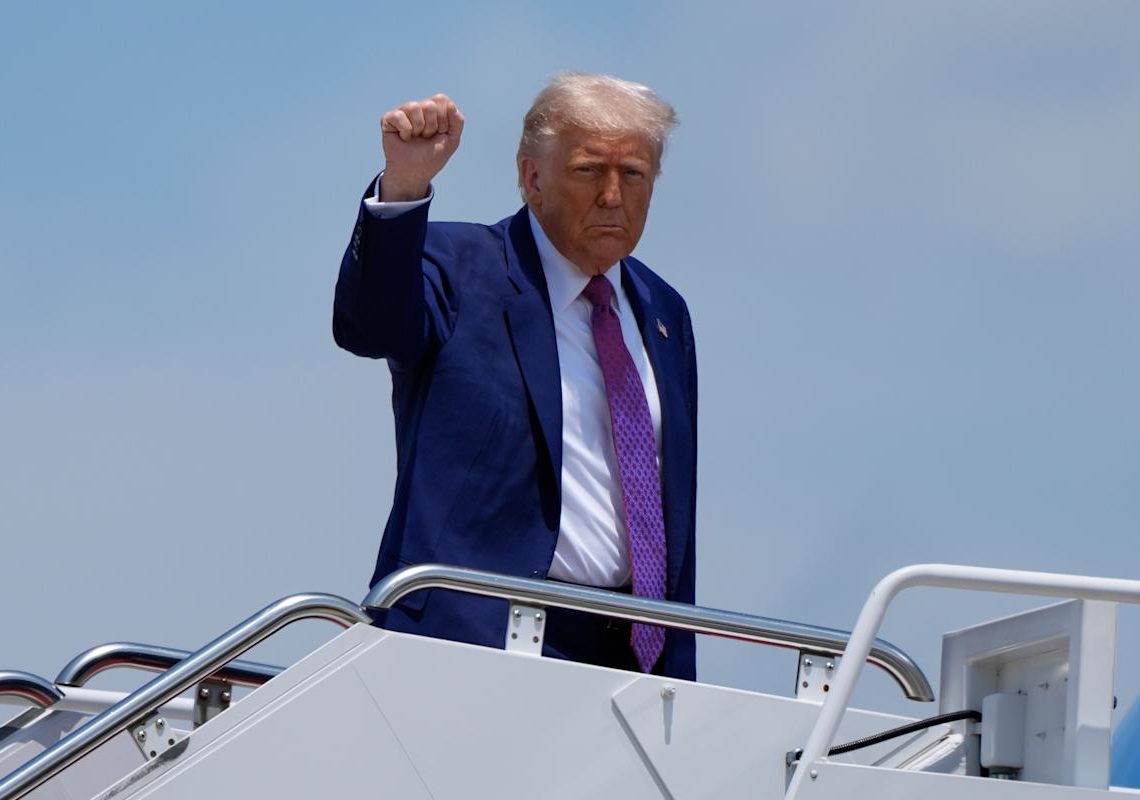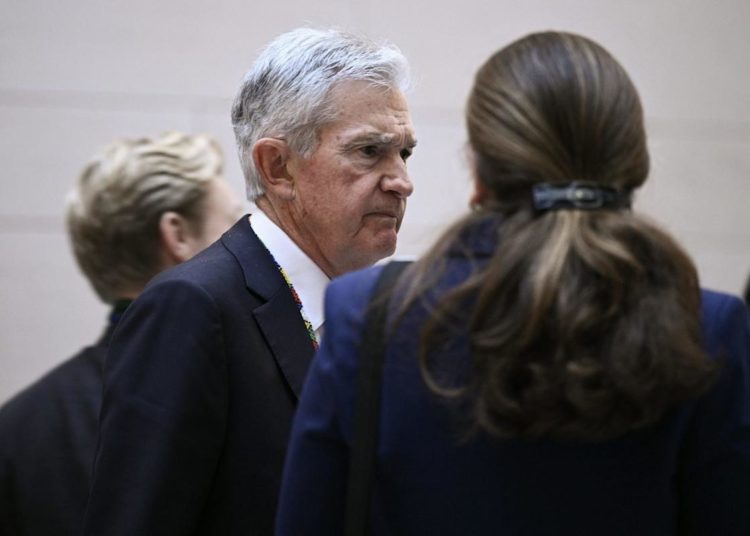For the second time in two months, President Donald Trump on Wednesday touted a “deal” with China. There’s one problem: It’s largely the same deal the two countries agreed to last month.
And the initial readouts of the handshake agreement underscore just how far the Trump administration is from achieving its larger goals in the trade negotiations with Beijing.
“The two sides have already met once to try to de-escalate and basically agree to stop punching each other in the face with extreme tariffs,” said Emily Kilcrease, a former deputy assistant U.S. Trade Representative from 2019 to 2021. “And now they’ve come back together to say ‘Yes, we’ve already agreed we should stop punching each other in the face. Let’s actually stick to it this time.'”
Speaking late Tuesday in front of the ornate London mansion where they’d just held two days of talks, Commerce Secretary Howard Lutnick and U.S. Trade Representative Jamieson Greer told reporters the world’s two largest economies had agreed to ratchet back actions both sides have taken since they announced an initial deal to cool tensions on May 12. The “framework,” as officials from both countries described it, still needs to be approved by Trump and China’s leader, Xi Jinping, and many elements remain outstanding.
But the emerging details suggest the Trump administration is at a disadvantage. While the U.S. is promising additional concessions on the export of certain sensitive products to China and restarting Chinese student visas, Beijing has only recommitted to a pledge it made a month ago — lifting its blockade on shipments of critical minerals, which are essential components of everything from cars to computers to defense equipment. China controlled nearly 70 percent of the world’s mine production of those minerals in 2024, according to the U.S. Geological Survey. And control of that spigot is proving to be the ultimate pressure point in any tit-for-tat trade war.
“This is another band aid,” said Derek Scissors, a senior fellow at the American Enterprise Institute and the chief economist of the China Beige Book, a report that publishes data on the Chinese economy. “The Chinese can decide six months from now, ‘we don’t like what you said about the party,’ or ‘somebody was mean to Xi Jinping.’ They can decide that and cut off rare earths again.”
One person close to the White House and in touch with the delegation in London acknowledged the advances made in the latest round of meetings are small and tentative. “The administration knows that any deal with China isn’t worth the paper it’s written on, but they can at least try to move the ball forward,” said the person, who was granted anonymity to speak candidly about the state of negotiations. “This is not a trade deal. It’s a framework and there’s still a lot of details to be negotiated.”
The Trump administration, however, hinted at how desperate it is to restart the flow of critical minerals from China by offering to partially remove one of its biggest sources of leverage against China: export controls on sensitive technologies.
In his remarks to reporters Tuesday night, Lutnick said some of the export restrictions the U.S. has imposed on China in recent months on things like airplane parts and semiconductors and software would “come off … in a balanced way, when they approve the [critical minerals’] licenses.”
Kilcrease called that a “very dangerous precedent.”
“There was always this view that the U.S. will impose export controls because it’s a matter of national security, and because it’s a matter of national security, we don’t negotiate over it. Now you’ve given China an opening in every single future conversation to come back in and push the United States on export controls,” she said. “And they’re not just going to push on the kind of new export controls that were put in place for leverage. They’re also going to push on the chip controls, the AI controls, all of the controls that they have hated for decades. We just opened the door to that.”
Dating back to the first Trump administration, the U.S. has used export controls as aggressively, if not more, than tariffs to reshape the U.S. relationship with China. The Trump administration has taken steps to widen that effort since the start of his second term in office, targeting lower grade chips used in everyday electronic devices, beyond what’s traditionally considered sensitive technology. Senior officials, particularly Lutnick, have vowed to strengthen controls and step up enforcement.
Despite those pledges, the U.S. faces pressure from top business leaders to loosen controls and allow greater access to the Chinese market, a pressure that isn’t matched in China’s authoritarian government.
Meanwhile, China holds a near monopoly on the global supply of rare earths — metallic elements essential to both civilian and military applications. And since December Beijing has imposed export restrictions on 11 such minerals as a second front in its deepening trade war with the U.S. and other Western countries.
All of those minerals are on the U.S. Geological Survey’s list of 50 “critical minerals” essential to “the U.S. economy and national security.” They include antimony, necessary to produce munitions, samarium which goes into precision weaponry and germanium which is a key to the production of military night vision equipment.
The U.S. has begun taking steps to develop its own rare earth mining and refining capabilities, starting under former President Joe Biden. But it remains decades behind Beijing in terms of domestic production and processing facilities, partly because of China’s own strategic and largely state-backed investments and efforts to flood the global supply chain.
China’s dominance over that supply chain, and the U.S.’s relatively small stockpile, makes it possible to put pressure on the U.S. side in a way that the administration has struggled to replicate.
“China has always had this trump card, they know how to use it, they’ve done it in the past and there’s no reason to suspect that they wouldn’t play it going forward,” said Marc Busch who has advised both USTR and the Commerce Department on technical trade barriers and is now a professor of international business diplomacy at Georgetown University.
It is unclear how long this current trade truce will hold. Beijing isn’t completely toning down its rhetoric despite the temporary reprieve. China’s Commerce Ministry described the export restrictions on rare earths as “common international practice” due to their “military and civilian purposes” in an X post Monday.
And Chinese state news agency Xinhua called criticism of those curbs “misleading hype” and defended them as a “responsible measure to uphold international nonproliferation measures” in an X post Tuesday.
The Chinese government, meanwhile, has not commented on the framework agreement reached in London, beyond vague statements by its delegation heads. China’s lead international trade negotiator, Li Chenggang, told reporters, per Chinese state media that “the two sides have agreed in principle the framework for implementing consensus.” Chinese Vice Premier He Lifeng called the London meeting “an important consultation” without elaborating on its details, Chinese state media reported Wednesday.
Beijing took a more gloating tone in a Xinhua state news agency oped published Wednesday that portrayed the Trump administration as the loser in its trade spat with China. “Washington was forced to spend billions in subsidies to offset farm losses, while companies struggled with rising costs of imported parts. The net effect has been supply chain chaos, business uncertainty and a lack of any clear strategic gain,” said the oped.
Still, one Trump ally said that framework marks “a critical step and traditional sign of progress in trade negotiations.”
“Beyond Geneva, it opens up the ongoing negotiations. Progress on trade agreements is always incremental, complexity takes time,” said the Trump ally, granted anonymity to speak candidly about the negotiations with China. “Both sides have political and economic vital interests to protect and advance.”
Trump, meanwhile, continues to push for a face-to-face meeting with Xi, which has been a diplomatic focus for much of his second term. After a call with Xi last week, Trump said that he had invited the Chinese Communist Party leader to the White House and that he had accepted an invitation to China and would visit “at a certain point.”
Any such meeting could hold more water than the formal negotiations, which have been led by Trump’s triumvirate on trade: Treasury Secretary Scott Bessent, Greer and now Lutnick.
“Unless we get a Trump-Xi meeting, I don’t see that we can write an agreement that will stand,” Scissors said. “And it won’t stand, because the Chinese will remain aggressive as they have been the entire time Xi Jinping has been in his party position, which is now 12 and a half years, and because the US will remain volatile While Donald Trump is president.”
The post Trump’s latest trade ‘deal’ with China underscores key U.S. disadvantage appeared first on Politico.



